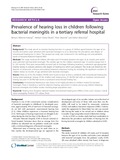| dc.description.abstract | OBJECTIVE:
To establish the proportion of children who develop sensorineural hearing loss after bacterial meningitis and to correlate such loss with patient factors.
STUDY DESIGN:
Retrospective case review.
SETTING:
McMaster University Children's Hospital, a tertiary referral center.
PATIENTS:
Children between the ages of 1 day and 18 years admitted to McMaster University Children's Hospital with a confirmed diagnosis of bacterial meningitis between January 1, 1991 and December 30, 2000.
INTERVENTIONS:
Audiological assessment including auditory brainstem responses and cortical electric-response audiometry or standard audiometry.
MAIN OUTCOME MEASURES:
The nature of sensorineural hearing loss was assessed according to the degree (mild to profound) and course (transient versus permanent). Correlations between sensorineural hearing loss and the patient's age, sex, duration of illness before admission, use of dexamethasone, concurrent neurologic complications, and types of pathogens were evaluated. Patterns of inpatient and outpatient audiological assessment were determined.
RESULTS:
Seventy-nine children had confirmed bacterial meningitis. Streptococcus pneumoniae accounted for 36.7 percent of all cases, followed-up by Neisseria meningitides (16.5%), group B Streptococcus (15.2%), and Hemophilus influenzae (13.9%). Sixty-eight (86.1%) children underwent hearing assessment, either as inpatients or after discharge. Of the remaining 11 (13.9%) in whom audiological evaluation could not be confirmed, only two made mention of a referral. As such, a nonreferral rate of 11.4 percent was identified. Abnormal auditory brainstem response findings were present in 22 cases (32.3%), with 11 cases (13.9%) of permanent sensorineural hearing loss identified. A statistically significant association between sensorineural hearing loss and Streptococcus pneumoniae was found (p < 0.001). No association between age, sex, duration of illness before admission, use of dexamethasone, and number of concurrent neurologic complications could be established.
CONCLUSIONS:
In our series, 11 children (13.9%) experienced permanent sensorineural hearing loss, consistent with previously reported rates of 5 to 35 percent within the pediatric population. Since introduction of the Hemophilus influenzae type B vaccine, Streptococcus pneumoniae has emerged as the dominant causative organism of bacterial meningitis in children. Our study additionally confirms the role of Streptococcus pneumoniae as a precipitant of sensorineural hearing loss (p < 0.001). Audiological assessment in our series (86.1%) exceeds most of the screening rates previously reported in the literature. Because of compliance problems with outpatient audiological assessment and because early identification and expedient amplification lead to better academic and language outcomes, routine inpatient audiological screening of postmeningitic children is advocated | en_US |


